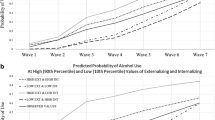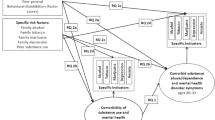Abstract
Externalizing psychopathology (EXT) is a framework for understanding diagnostic comorbidity and etiology of antisocial and substance-use behaviors. EXT indicates continuity in adulthood but the structure of adolescent EXT is less clear. This report examines whether adolescent EXT is trait-like, as has been found with adults, or categorical. We use tests of measurement invariance to determine how diagnostic indicators of EXT differ in adolescents compared to adults. The EXT measures employed were DSM-IIIR diagnoses of adult antisocial behavior, conduct disorder, and alcohol, marijuana, and drug dependence. Latent trait, latent class, and hybrid models were fit to two separate data sets: 2,769 seventeen-year-old adolescents and 2,619 adults from the Minnesota Twin Family Study. The best model in both samples was a single-trait LT model. Parameters from the adolescent and adult models were equivalent for all disorders except alcohol dependence. It appears that EXT in adolescence can be accurately represented by a single-trait model, and the measurement properties of EXT are similar during these time periods with the exception of alcohol dependence.
Similar content being viewed by others
References
Achenbach, T. M., & Edelbrock, C. S. (1984). Psychopathology of childhood. Annual Review of Psychology, 35, 227–256.
Akaike, H. (1974). A new look at the statistical model identification. IEEE Transactions on Automatic Control, 19, 716–723.
American Psychiatric Association. (1987). Diagnostic and statistical manual of mental disorders (3rd ed.). Washington, DC: Author.
Anthony, J. C., Warner, L. A., & Kessler, R. C. (1994). Comparative epidemiology of dependence on tobacco, alcohol, controlled substances, and inhalants: Basic findings from the National Comorbidity Survey. Experimental and Clinical Psychopharmocology, 2, 244–268.
Armstrong, T., & Costello, E. (2002). Community studies on adolescent substance use, abuse, or dependence and psychiatric comorbidity. Journal of Consulting Clinical Psychology, 70, 1224–1239.
Bornovalova, M. A., Hicks, B. M., Iacono, W. G., & McGue, M. (2010). Familial transmission and heritability of childhood disruptive disorders. American Journal of Psychiatry, 167, 1066–1074.
Carlson, S. R., Katsanis, J., Iacono, W. G., & Mertz, J. K. (1999). Substance dependence and externalizing psychopathology in adolescent boys with small, average, or large P300 event-related potential amplitude. Psychophysiology, 36, 583–90.
Cloninger, C. (1987). Neurogenetic adaptive mechanisms in alcoholism. Science, 236, 410–416.
Dick, D. M. (2007). Identification of Genes Influencing a Spectrum of Externalizing Psychopathology. Current Directions in Psychological Science, 16, 331–335.
Disney, E., Elkins, I., McGue, M., & Iacono, W. (1999). Effects of ADHD, conduct disorder, and gender on substance use and abuse in adolescence. American Journal of Psychiatry, 156, 1515–1521.
Elkins, I., King, S., McGue, M., & Iacono, W. (2006). Personality traits and the development of nicotine, alcohol, and illicit drug disorders: prospective links from adolescence to young adulthood. Journal of Abnormal Psychology, 115, 26–39.
Embretson, S., & Reise, S. (2000). Item response theory for psychologists. Mahwah: Erlbaum.
Farmer, R., Seeley, J., Kosty, D., & Lewinsohn, P. (2009). Refinements in the hierarchical structure of externalizing psychiatric disorders: Patterns of lifetime liability from mid-adolescence through early adulthood. Journal of Abnormal Psychology, 118, 699–710.
Gelhorn, H., Hartman, C., Sakai, J., Mikulich-Gilbertson, S., Stallings, M., & Young, S. (2009). An item response theory analysis of DSM-IV conduct disorder. Journal of the American Academy of Child and Adolescent Psychiatry, 48, 42–50.
Grove, W. M. (1991). When is a diagnosis worth making? A comparison of two statistical prediction strategies. Psychological Reports, 68, 3–17.
Grove, W. M., & Vrieze, S. I. (2010). On the substantive grounding and clinical utility of categories versus dimensions. In T. Millon, R. F. Krueger, & E. Simonsen (Eds.), Contemporary directions in psychopathology: Toward DSM-V and ICD-11. New York: Guilford Press.
Heinen, T. (1996). Latent class and discrete latent trait models: Similarities and differences. Thousand Oaks: Sage.
Helzer, J. E., Kraemer, H. C., Krueger, R. F., Wittchen, H.-U., Sirovatka, P. J., & Regier, D. A. (2008). Dimensional approaches in diagnostic classification: refining the research agenda for DSM-V. Arlington: American Psychiatric Association.
Hicks, B. M., Bernat, E. M., Malone, S. M., Iacono, W. G., Patrick, C. J., Krueger, R. F., et al. (2007b). Genes mediate the association between P3 amplitude and externalizing disorders. Psychophysiology, 44, 98–105.
Hicks, B., Blonigen, D., Kramer, M., Krueger, R., Patrick, C., Iacono, W., et al. (2007a). Gender differences and developmental change in externalizing disorders from late adolescence to early adulthood: A longitudinal twin study. Journal of Abnormal Psychology, 116, 433–447.
Hicks, B., Krueger, R., Iacono, W., McGue, M., & Patrick, C. (2004). Family transmission and heritability of externalizing disorders: a twin-family study. Archives of General Psychiatry, 61, 922–928.
Holdcraft, L. C., & Iacono, W. G. (2004). Cohort effects on gender differences in alcohol dependence. Addiction, 97, 1025–1036.
Iacono, W. G., Carlson, S. R., et al. (2002). P3 event-related potential amplitude and the risk for disinhibitory disorders in adolescent boys. Arch Gen Psychiatry, 59, 750–757.
Iacono, W., & McGue, M. (2002). Minnesota Twin Family Study. Twin Research, 5, 482–487.
Kendler, K., Davis, C., & Kessler, R. (1997). The familial aggregation of common psychiatric and substance use disorders in the National Comorbidity Survey: a family history study. British Journal of Psychiatry, 170, 541–548.
Kendler, K., Prescott, C., Myers, J., & Neale, M. (2003). The structure of genetic and environmental risk factors for common psychiatric and substance use disorders in men and women. Archives of General Psychiatry, 60, 929–937.
Krueger, R. F., Hicks, B., Patrick, C., Carlson, S., Iacono, W., & McGue, M. (2002). Etiologic connections among substance dependence, antisocial behavior, and personality: modeling the externalizing spectrum. Journal of Abnormal Psychology, 111, 411–424.
Krueger, R. F., Markon, K. E., Patrick, C. J., Benning, S. D., & Kramer, M. D. (2007). Linking antisocial behavior, substance use, and personality: An integrative quantitative model of the adult externalizing spectrum. Journal of Abnormal Psychology, 116, 645–666.
Krueger, R. F., Markon, K. E., Patrick, C., & Iacono, W. (2005). Externalizing psychopathology in adulthood: a dimensional-spectrum conceptualization and its implications for DSM-V. Journal of Abnormal Psychology, 114, 537–550.
Kuha, J. (2004). AIC and BIC: Comparisons of assumptions and performance. Sociological Methods Research, 33, 188–229.
Lahey, B., Rathouz, P., Van Hulle, C., Urbano, R., Krueger, R., Applegate, B., et al. (2008). Testing structural models of DSM-IV symptoms of common forms of child and adolescent psychopathology. Journal of Abnormal Child Psychology, 36, 187–206.
Lazarsfeld, P., & Henry, N. (1968). Latent structure analysis. Boston: Houghton Mifflin.
Leckman, J. F., Sholomskas, D., Thompson, W. D., Belanger, A., & Weissman, M. M. (1982). Best estimate of lifetime psychiatric diagnosis: A methodological study. Archives of General Psychiatry, 39, 879–883.
Lynskey, M., & Fergusson, D. (1995). Childhood conduct problems, attention deficit behaviors, and adolescent alcohol, tobacco, and illicit drug use. Journal of Abnormal Child Psychology, 23, 281–302.
Markon, K. E., Chmielewski, M., & Miller, C. J. (2011). The reliability and validity of discrete and continuous measures of psychopathology: A quantitative review. Psychological Bulletin, 137, 856–879.
Markon, K., & Krueger, R. (2005). Categorical and continuous models of liability to externalizing disorders: a direct comparison in NESARC. Archives of General Psychiatry, 62, 1352–1359.
McArdle, J. J. (2009). Latent variable modeling of differences and changes with longitudinal data. Annual Review of Psychology, 60, 577–605.
McGue, M., Iacono, W., Legrand, L., Malone, S., & Elkins, I. (2001). Origins and consequences of age at first drink. I. Associations with substance-use disorders, disinhibitory behavior and psychopathology, and P3 amplitude. Alcohol: Clinical Experimental Research, 25, 1156–1165.
Meehl, P. E. (2001). Comorbidity and taxometrics. Clinical Psychology: Science and Practice, 8, 507–519.
Meredith, W. (1993). Measurement invariance, factor analysis, and factorial invariance. Psychometrika, 58, 525–543.
Moffitt, T. (1993). Adolescence-limited and life-course-persistent antisocial behavior: a developmental taxonomy. Psychological Review, 100, 674–701.
Muthen, B. O. (2006). Should substance use disorders be considered as categorical or dimensional? Addiction, 101, 6–16.
Muthen, B. O., & Asparouhov, T. (2006). Item response mixture modeling: Application to tobacco dependence criteria. Addictive Behaviors, 31, 1050–1066.
Muthen, L. K. & Muthen, B. O. (1995–2010). Mplus user’s guide. Los Angeles, CA: Muthen & Muthen.
Muthen, B., & Shedden, K. (1999). Finite mixture modeling with mixture outcomes using the EM algorithm. Biometrics, 55, 463–469.
National Institute of Health. (2010). Scientific Management Review Board. Report on Substance Use, Abuse, and Addiction Research at NIH. Bethesda: Author.
Nock, M. K., Kazdin, A. E., Hiripi, E., & Kessler, R. C. (2006). Prevalence, subtypes, and correlates of DSM-IV conduct disorder in the National Comorbidity Survey Replication. Psychological Medicine, 36, 699–710.
Odgers, C. L., Moretti, M. M., Burnette, M. L., Chauhan, P., Waite, D., & Reppucci, N. D. (2007). A latent variable modeling approach to identifying subtypes of serious and violent female juvenile offenders. Aggressive Behavior, 33, 339–352.
Patrick, C. J., Bernat, E. M., Malone, S. M., Iacono, W. G., Krueger, R. F., & McGue, M. (2006). P300 amplitude as an indicator of externalizing in adolescent males. Psychophysiology, 43, 84–92.
Reich, W., & Welner, Z. (1988). Diagnostic interview for children and adolescents—Revised: DSM-III-R Version (DICA-R). St. Louis: Washington University.
Robins, L. M., Babor, T., & Cottler, L. B. (1987). Composite international diagnostic interview: Expanded substance abuse module. St. Louis: Authors.
Robins, L. M., Wing, J., Wittchen, H. U., Helzer, J. E., Babor, T. F., Burke, J., et al. (1988). The Composite International Diagnostic Interview: An epidemiologic instrument suitable for use in conjunction with different diagnostic systems and in different cultures. Archives of General Psychiatry, 45, 1069–1077.
Sanislow, C. A., Pine, D. S., Quinn, K. J., Kozak, M. J., Garvey, M. A., Heinssen, R. K., et al. (2010). Developing constructs for psychopathology research: Research Domain Criteria. Journal of Abnormal Psychology, 119, 631–639.
Schwarz, G. (1978). Estimating the dimension of a model. Annals of Statistics, 6, 461–464.
Slutske, W., Heath, A., Dinwiddie, S., Madden, P., Bucholz, K., Dunne, M., et al. (1998). Common genetic risk factors for conduct disorder and alcohol dependence. Journal of Abnormal Psychology, 107, 363–374.
Spitzer, R. L., Williams, J. B. W., Gibbon, M., & First, M. B. (1987). Structured clinical interview for DSM-III-R personality disorders (SCID-II). New York: New York State Psychiatric Institute, Biometrics Research.
Takane, Y., & de Leeuw, J. (1987). On the relationship between item response theory and factor analysis of discretized variables. Psychometrika, 52, 393–408.
Taylor, J., Iacono, W. G., & McGue, M. (2000). Evidence for a genetic etiology of early-onset delinquency. Journal of Abnormal Psychology, 109, 634–643.
Walton, K. E., Ormel, J., & Krueger, R. F. (2011). The dimensional nature of externalizing behaviors in adolescence: Evidence from a direct comparison of categorical, dimensional, and hybrid models. Journal of Abnormal Child Psychology, 39, 553–561.
Widaman, K. F., Ferrer, E., & Conger, R. D. (2010). Factorial invariance within longitudinal structural equation models: Measuring the same construct across time. Child Development Perspectives, 4, 10–18.
Windle, M., & Scheidt, D. (2004). Alcoholic subtypes: Are two sufficient? Addiction, 99, 1508–1519.
Yang, Y. (2005). Can the strengths of AIC and BIC be shared? Biometrika, 92, 937–950.
Young, S., Stallings, M., Corley, R., Krauter, K., & Hewitt, J. (2000). Genetic and environmental influences on behavioral disinhibition. American Journal of Medical Genetics, 96, 684–695.
Acknowledgments
This research was supported by grants R01DA05147, R01AA09367, and 5T32MH017069 (Vrieze) of the National Institutes of Health.
Author information
Authors and Affiliations
Corresponding author
Rights and permissions
About this article
Cite this article
Vrieze, S.I., Perlman, G., Krueger, R.F. et al. Is the Continuity of Externalizing Psychopathology the Same in Adolescents and Middle–Aged Adults? A Test of the Externalizing Spectrum’s Developmental Coherence. J Abnorm Child Psychol 40, 459–470 (2012). https://doi.org/10.1007/s10802-011-9571-x
Published:
Issue Date:
DOI: https://doi.org/10.1007/s10802-011-9571-x




